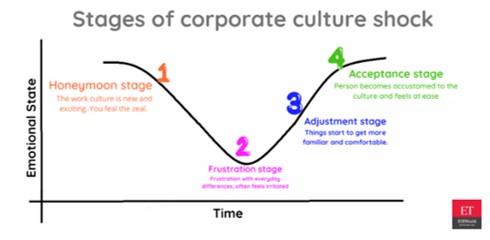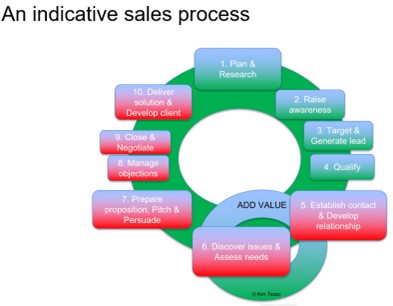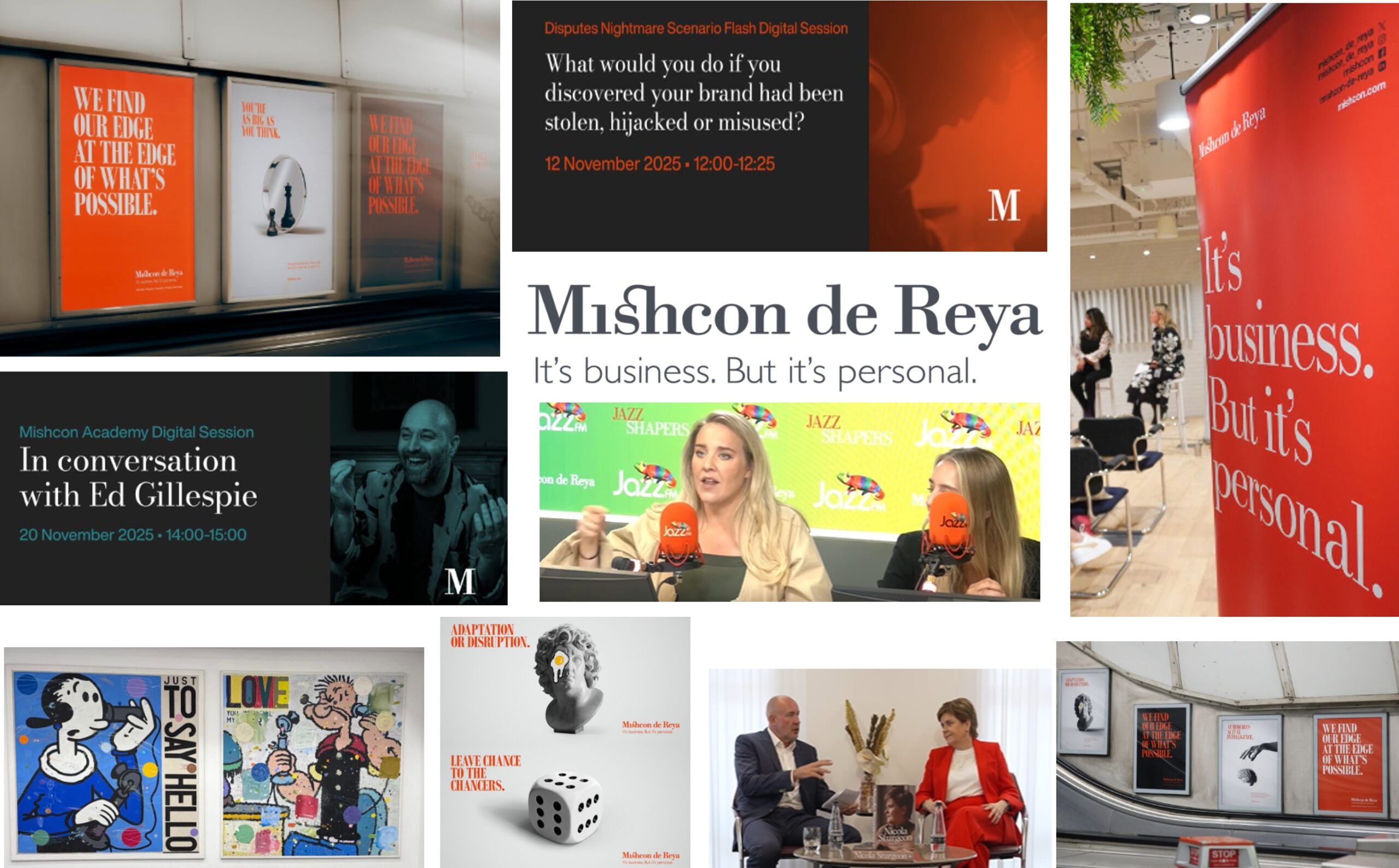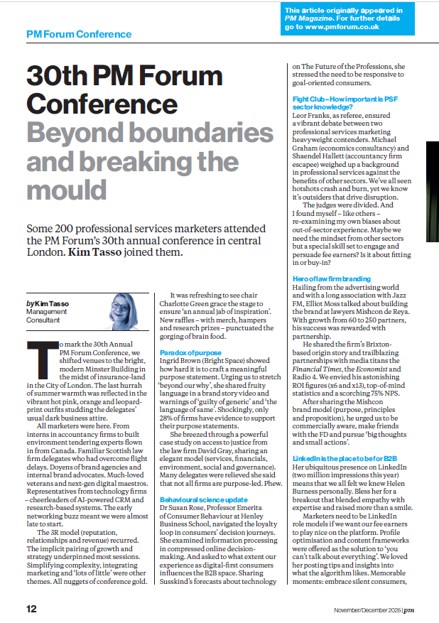
Just before Easter I spent a day facilitating the popular PM Forum training workshop “The Proactive M&BD Executive”. With a full house of marketing and business development executives from legal and accountancy firms across the UK it was an interactive, valuable and fun day (Thank you delegates for your spirited engagement and thanks to Morag Campbell for your superb technical hosting!). As an additional learning resource for delegates, I review the key themes of The Proactive M&BD Executive – Culture shock, marketing models, fee-earner engagement, qualifications and social media. Detailed delegate poll results and feedback are shown towards the end of the post.
Culture shock and the never-ending “to do” list
Some of the delegates described the “culture shock” they experienced as they entered a M&BD role in the professional services sector. This is a common theme when M&BD people move from another sector into professional services. Some of the most common issues include:
- Surprise at the lack of an overall strategy and aligned plans
- Shock at the lack of the data and analytics upon which modern marketing practice is based (and against which results are assessed)
- Concern at the sheer volume and complexity of campaigns and activities required across numerous sectors and multiple service lines
- Frustration at the reliance on the engagement and co-operation of always busy and sometimes reluctant fee-earners.
- Disbelief at the lack of process and automation and the often slow and sometimes convoluted decision-making processes within a partnership
- Disconnection as a result of the lack of direct client contact – in most sectors the marketing and business development professionals are the main gateway to clients, in professional services they are often one-step removed from clients
- Exhaustion at the seemingly never-ending stream of urgent requests from fee-earners – often all of equal priority – which add to the never-ending “to do” list
Delegate comments included “With regards to ‘culture shock’ mentioned at the beginning of the session, I have really had to adjust to being in a partner-led industry where so many people have an opinion and a say in how things are done. It’s great that people have a vested interest but it can be hard to manage and get a final sign off”.
“How can I be proactive when we are just trying to keep our head above water with constant pitch/event requests. I’ve recently moved from a very proactive position, to an extremely reactive environment due to the quantity of requests. In my first week, the week before Christmas, I worked on four pitches. Previously, my proactive activities were large projects that I took on e.g. implementing an experience database, a tidy up of our CRM systems. I don’t have the capacity right now to look at doing that (and being a large firm, we probably have departments who will do that as a part of their remit), what smaller things can I do to add value?”
“Also regarding the culture shock that we discussed earlier, my previous role was a marketing assistant for a small business in the online retail industry and I have now moved on to be an executive in a large firm in professional services and they couldn’t be more different from each other! I’m still only a few months in and am still learning every day – but how can I step up in my new role and use the skills I’ve learnt from B2C and apply them within a B2B role effectively? Do you feel there is a lot of crossover between them?”
This post from April 2022 reflects on how M&BD Executives can be more proactive Reflections from Marketing and Business Development Executives (kimtasso.com) :
- Develop your marketing knowledge base
- Communicate clearly and assertively
- Adopt an evidence-based and emotional approach
- Concentrate on what you can influence
- Be strategic
- Involve fee-earners early in the planning process
- Think like a consultant
- Manage your time wisely
- Measure everything
- Invest in your personal development
- Plan your career
With regards to releasing time to be more proactive see this November 2022 post become a more proactive Marketing and Business Development Executive (kimtasso.com)
Marketing models in professional services – B2C, B2B and P2P
Professional services firms are unusual in that they often have both B2C (Business-to-Consumer e.g. residential conveyancing) and B2B (Business-to-Business e.g. commercial law) markets and services.
The situation is further complicated by the fact that different B2B services might have significantly different client journeys and sales cycles and thus strategies. Furthermore, many transactional services are often promoted through third party referrers and intermediaries – another form of B2B.
However, the digital revolution reduced the distinction between B2C (Business to Consumer) and B2B marketing with increasing use of digital marketing throughout the professional services client journey. Increasingly, we are working with a P2P (Person-to-Person) model.
Traditional marketing models (e.g. RACE by Dave Chaffey) focus on customer acquisition (Reach, Act, Convert, Engage). An interesting book with more emphasis on customer expansion is The Loop by The Pedowitz Group (TPG) Pedowitz_FTheFunnel_ebook2 (pedowitzgroup.com) which covers:
- Customer acquisition
- Unaware
- Aware
- Consideration
- Evaluation
- Decision
- Customer expansion
- Onboard
- Adoption
- Value realisation
- Loyalty
- Advocacy
Why do we refer to clients rather than customers in professional services?
Another aspect of the culture shock is that in professional services we refer to clients rather than customers.
According to the Oxford dictionary, a customer is “a person or an organization that buys goods or services from a shop or business,” and a client is “a person who uses the services or advice of a professional person or organization.” HubSpot puts it more succinctly: customers buy products, and clients buy advice and solutions.
Customers are mainly taking part in a one-time transaction to satisfy a short-term or singular need, while clients are taking part in a business relationship over time that satisfies a series of needs.
And most professional service firms are regulated by a professional body which places additional responsibilities on them. For example, Solicitors must act with honesty and integrity at all times. Solicitors and their staff must keep their client’s business confidential. Solicitors must act in their client’s best interests, although they must balance this duty with their other duties such as their duty to the courts or other solicitors.
How do we increase fee-earner engagement with M&BD?
One of the polls revealed that 83% (15 delegates) had occasional difficulties in relationships with fee-earners and 17% (3 delegates) said they often did. There were a number of questions throughout the day on how to increase fee-earner engagement. For example:
- Any thoughts on some useful language/techniques to motivate BD-shy fee-earners to commit more time/energy to BD exercises? There is a wide spectrum of engagement across the firm
- What can I do to motivate fee-earners and Client Relationship Partners (CRPs) to communicate better with the M&BD to ensure we are providing clients with the best service?
- How do you get around fee-earners who are slightly sceptical about M&BD and aren’t as responsive to ideas or concepts? I’ve found some fee-earners don’t contribute to the smaller projects which subsequently slows the larger project down
There are focused workshops on achieving buy-in and stakeholder management. Some relevant posts include:
Key issues in Marketing and Business Development Planning (kimtasso.com) July 2022
Ten top takeaways on stakeholder engagement and buy in (kimtasso.com) April 2022
Seven thoughts on stakeholder management, engagement and buy-In (kimtasso.com) April 2021
Animal magic of buy-in and stakeholder engagement (Video) (kimtasso.com) September 2020
Animal magic and the art of gaining buy-in: Leeds September 2019 (kimtasso.com) October 2019
all about buy-in in professional services (Manchester and Dublin 2019) (kimtasso.com) March 2019
Stakeholder management and buy-in session (kimtasso.com) August 2016
Are marketing qualifications worthwhile for professional services?
56% of the delegates had marketing qualifications. On the many questions about marketing qualifications (see “Half way reflections and questions” below) I explained that I was an advocate of marketing qualifications (but some directors may place a higher value on experience and track record). I encourage marketing qualifications in professional services for a number of reasons:
- We work in professional services where all lawyers, accountants, patent attorneys, tax advisers and surveyors place a high value on professional qualifications and Continuing Professional Development (CPD)
- CIM professional qualifications are practitioner-based – you have to demonstrate your ability to apply theory to real life situations
- CIM qualifications are widely recognised – even beyond the UK. They can differentiate you from non-qualified candidates
- You can opt for traditional or digital streams in CIM qualifications
- Many professional services firms will contribute to or cover the cost of CIM qualifications for their M&BD professionals
- Having a professional marketing qualification will improve your confidence significantly
- There is a version of the CIM qualification that is tailored for professional services – and uses tutors that have professional services experience (see CIM qualifications for professional services marketers | Cambridge Marketing College – Level 6)
See New CIM professional marketing qualifications – 2020 (kimtasso.com) and Marketing Manager Apprenticeship – a Level 6 Qualification (kimtasso.com)). A delegate shared the link for a CIM open day on 2nd May Meeting Registration – Zoom
However, if you already have a formal marketing education then you might consider broadening your commercial knowledge with an MBA or technical knowledge of other functions such as finance, technology or human resources (see Future Marketing Manager – T-shaped people, senior promotions (kimtasso.com)).
Social media in professional services
Delegates asked a number of questions about social media for professional services and then shared their thoughts.
What are the main social media platforms for professional services?
The consensus was that LinkedIn was the most important platform for professional services. A few mentioned Twitter as well – although recently engagement on this platform has reduced.
Others comments included:
- Shoosmiths has just started using TikTok
- It seems like lots of firms are resisting using Instagram but we have started using it to market ourselves to potential employees and demonstrate our culture
- Our group had a discussion about Instagram and TikTok being a good platform to show more of the company culture and ‘people’ side of things but firms seem to be a bit stuck in their ways!
- I think ultimately it depends on your target clients
- I manage the Saffery Instagram account and we post a lot of the fun things we do within the firm, we have a lot of good feedback
- Boodle Hatfield are using Instagram for its Arts Team, which gets great feedback
- MHA Macintyre Hudson accountants (mhamacintyrehudson) also use Instagram for showing company culture and give that human feel to the company as well as recruitment for the company
How do you persuade lawyers and accountants to use TikTok and Instagram?
One delegate asked for ideas/tips on how to get team members more on board with the use of TikTok and Instagram. There were questions about whether these platforms attracted the right demographics for professional services – although the value for recruitment was acknowledged.
In essence, the debate was around both showing them the personal, team and firm wide benefits and reducing their concerns about the costs (their time) and risks. There were also suggestions to show them examples of where it is working with other similar firms. Check this out The 10 best legal social media users of 2023 – Legal Cheek and see the material above on buy-in generally.
The following posts might also be useful:
Influencer marketing in professional services (kimtasso.com)
Social Media in business development: A Guide for Lawyers (kimtasso.com)
Social media in business development and relationship management (kimtasso.com) Review by Pippa Blakemore
Help your lawyers understand and engage with social media effectively (kimtasso.com)
social media helpful for lawyers, accountants and surveyors? (kimtasso.com)
Is social media relevant for lawyers, accountants and surveyors? – Kim Tasso
Advanced social media use amongst lawyers, accountants and surveyors – Kim Tasso
Law Firm Social Media Strategy: The Ultimate Checklist (good2bsocial.com)
How can we improve the performance of social media posts?
There are numerous responses to this question including: the quality of the content, integration within campaigns, use of analytics, target audience engagement with the platform, video and visual content, tagging and links, call to action and interaction, copywriting, design, optimising the day and time of posting and internal amplification.
PM Forum provides dedicated training courses on digital marketing – including social media and digital content production.
Delegate responses and poll results
These are responses from the delegates to questions and polls. They find it helpful to compare and benchmark their views and answers to their peers.
What does proactive mean?
- Take action before it is needed
- See opportunities and act on them
- Thinking ahead
- Going above and beyond
- Forward planning
- Thinking and planning ahead
- Working to the best of your ability
- Creating strong relationships
- Taking the lead
- Pre-planning
- Thinking ahead
- Showing initiative
- Doing things without being asked to
- Anticipating the future
- Looking ahead for opportunities and taking initiative
- Ideas
- Taking ownership
- Working quickly
How confident do you feel in your role?
| Start of session | End of session | |
| 1 – Low | ||
| 2 | ||
| 3 | ||
| 4 | 11% (2) | |
| 5 | 6% (1) | 6% (1) |
| 6 | 28% (5) | |
| 7 | 28% (5) | 33% (6) |
| 8 | 22% (4) | 39% (7) |
| 9 | 6% (1) | 22% (4) |
| 10 – High |
Is your role mainly:
- Strategic marketing 6% (1)
- Tactical marketing/Communications 28% (5)
- Information management/administration 0%
- Selling/pitching 6% (1)
- Relationship management/development 6% (1)
- All of these things 56% (10)
How much time do you have to be proactive at present?
20% x3
25% x2
40% x4
50%
70%
Where is most of your time spent?
- Marketing/BD planning 44% (8)
- Awareness raising 28% (5)
- Lead generation 6% (1)
- Winning new business 11% (2)
- Developing existing relationships 11% (2)
What would you do with a “free day”?
- Complete my forever growing to do list
- Forward plan social media posts for the month
- Sit down and have discussions with fee-earners about their aims in BD, and how I can help them reach those goals
- Take a look at projects that may have slipped through the cracks
- Research and create brief for a new website page design
- Plan ahead for future projects
What makes people appear confident?
- Body language
- Well spoken
- Energy
- Eye contact
- No fillers such as ‘um’
- Smile
- Not hesitating or stuttering
- Clear voice projection
- Bubbly
- Friendly face
- Being concise
- Speak at a natural pace
Soft skills – Boost your self-confidence and confidence (Video) (kimtasso.com)
Be more confident and convey confidence – top tips (kimtasso.com)
Proactive Marketing and BD Executive – Data, Reach, Qualifications, Skills (kimtasso.com)
Insights into assertiveness, confidence and effectiveness (kimtasso.com)
Assertiveness confidence and effectiveness (kimtasso.com)
Which segmentation approaches are used at your firm?
- Market/industry sector 78% (14)
- Size of business 22% (4)
- Job function 17% (3)
- Geography 17% (3)
- Nature of relationship 22% (4)
- A mixture 39% (7)
Do you have marketing/business development plan for:
- The firm 61% (11)
- The markets you serve 56% (10)
- The products/services promoted 56% (10)
- Each territory/region 22% (4)
- A mixture 28% (5)
How well does your firm track/monitor the source of leads?
- Really well across the firm 17% (3)
- Good in some teams 33% (6)
- OK 28% (5)
- Not very well 17% (3)
- Not at all 6% (1)
Do you measure client satisfaction?
- Yes – across the whole firm and all clients regularly 17% (3)
- Yes – for our largest clients 22% (4)
- Yes – for some clients or periodically 56% (10)
- No 6% (1)
Have you seen any crisis management plans at your firm?
- Yes 33% (6)
- No 67% (12)
What type of external consultants does your firm use?
- Brand 38% (6)
- Design and creative 38% (6)
- PR and copywriting 69% (11)
- Web design/development 69% (11)
- SEO 38% (6)
- PPC 0%
- Data management/Analytics 31% (5)
- Mailings 0%
- Events support 6% (1)
- Other 6% (1)
A few firms mentioned that they used external consultants to assist with directory entries.
Marketing systems
A number of systems commonly used by professional services firms were reviewed. Delegates added Canva for design and another commented “I can’t remember if monday.com | A new way of working was on the list but it’s the best project management system ever!” (Note: I have a family member in marketing who loves Notion – Your wiki, docs & projects. Together. For project management).
The growth of MarTech in professional services – an overview (kimtasso.com)
How technology drives marketing intelligence and efficiency (kimtasso.com)
Marketing technology system review – Clean contact data with Cirrom (kimtasso.com)
Half-way reflections and questions
Reflections
- Being in a break out room with loads of people in BD (something I personally have never done), and learning about what best practice they use and how they connect with fee earners/clients
- As a small team for a mid-size law firm, our biggest challenge is putting in place the things we need most and what to prioritise for our team as our needs are so broad
- From this morning’s discussion it seems collecting data on clients/competitors/attribution is going to be vital
- Great to see the perspective of those working in the same role at other firms, whether they are experienced or new to the role and coming at it with fresh ideas
Questions
- What actions can I take to make fee-earners see the bigger picture when going through tasks for marketing briefs?
- As someone with no formal marketing education and having transitioned from another role within the firm, how can I convince stakeholders and partners to take me seriously and come across confidently?
- Would you say the type of strategic device matters and are they for specific things or can you choose any?
- How do I get my opinions and voice heard among more senior colleagues? Are there any tips for how to deal with those kind of meetings / getting buy in from people more senior (whether fee earners or support staff)?
- A question regarding the CIM qualifications – is it worth doing? How much information is actually retained? Trying to study alongside your job? Is experience in the role more valuable?
- How useful is it to have a CIM qualification on top of a Business and Marketing degree? And what would be more valuable between a CIM qualification or a Masters degree?
- Would you recommend doing a professional marketing diploma as it incorporates digital marketing? Or is the digital marketing more relevant as technology is evolving etc?
Do you have people directly reporting to you?
- Yes 18% (3)
- I used to 6% (1)
- No 65% (11)
- I will soon 12% (2)
How often do you experience difficulties in your relationships with fee-earners?
- Never 0%
- Occasionally 83% (15)
- Often 17% (3)
- All the time 0%
Break-out questions on fee-earner engagement (using emojis)
While all groups produced creative and fun images in response to the break-out questions, one group submitted emojis.
- How do fee-earners view marketing/BD? 🙄😒🕰️ (annoying, we’re always on their backs for things, waste of time)
- Why don’t fee-earners co-operate more with marketing/BD? 🥴🕰️ (confusion, time consuming, they don’t understand what we do)
- How do we view the fee-earners? 🥱🤖👨🦳👶 (boring, robots, stuck in their ways, childish at times)
- What do the fee-earners expect/want from marketing/BD? 💻🌩️ (they think things are easy to do/complete, we can do things as fast as lightning)
- How can we get closer to the fee-earners? 🏇💰 (lasso them in, making them listen with a good incentive like money)
- How can we get fee-earners to ‘buy in’? 🥳💸🥇 (celebrate them, money, they want to be the best in their field and our help can assist them)
Have you had formal training in selling?
- Yes 11% (2)
- No – self-taught/experience 50% (9)
- No – unfamiliar with sales/selling concepts 39% (7)
Key takeaways from delegates
- Gather evidence and data to win over fee earners – show value
- Confidently communicate value
- Pick your battles wisely and know how to “play the game”.
- Prioritising my time using the jar metaphor – I’ll try and implement the suggestion of starting the day by spending some time on my small but important tasks and then allocate time to big projects
- Eat the frog
- Ask questions!
- Less is more
- Be more confident in my skill set when approaching fee-earners
- Value of gaining a qualification in the field to help better lay the foundations of my own development across the next few years
- Prioritising work – eat the frog!
- Make a mind map of career progression options
- Research CIM
- Read more blogs on trend forecasts in professional services
- Do less, but do it better
- Invest in personal development – CIM
- Try different ways of getting my ideas across e.g. campaigning, sneaking
- Look at ways to learn more about clients and fee-earners needs
- Lots of actions and insights to take away from today! But my main action is to do the CIM course to extend my knowledge and my confidence
- Look into courses (as I see gaps in my knowledge that I think will be crucial to thinking in that more “strategic consultant” way)
- Remember to be confident when presenting ideas
- Look at courses to help improve my marketing and BD knowledge! Not something I knew was an option for me so really keen to look into this further
Related posts for M&BD Executives
Marketing and Business Development (M&BD) Assistants (kimtasso.com) March 2023
become a more proactive Marketing and Business Development Executive (kimtasso.com) December 2022
Reflections from Marketing and Business Development Executives (kimtasso.com) April 2022
Proactive Marketing Executive – Plans, Budgets, Relationships and Career (kimtasso.com) September 2021
Proactive Marketing and BD Executive – Data, Reach, Qualifications, Skills (kimtasso.com) April 2021
Proactive Marketing/BD Executive (Oct 2020) – Session highlights (kimtasso.com) October 2020
Six themes for Proactive Marketing and BD Executives (2019) (kimtasso.com) January 2020
Top 10 takeaways – Proactive Marketing Executive (Feb 2019) (kimtasso.com) June 2019









